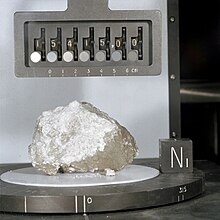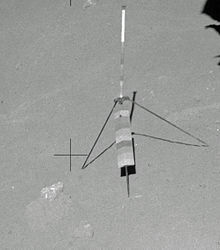Genesis Rock



The Genesis Rock (sample 15415) is a sample of Moon rock retrieved by Apollo 15 astronauts James Irwin and David Scott in 1971 during the second lunar EVA, at Spur crater. With a mass of ca. 270 grams (9.5 oz),[1] it is currently stored at the Lunar Sample Laboratory Facility in Houston, Texas.
Rock[]
Chemical analysis of the Genesis Rock indicated it is an anorthosite, composed mostly of a type of plagioclase feldspar known as anorthite. The rock was formed in the early stages of the Solar System, at least 4 billion years ago.[2]
It was originally thought they had found a piece of the Moon's primordial crust, but later analysis initially showed that the rock was only 4.1 ± 0.1 billion years old, which is younger than the Moon itself, and was formed after the Moon's crust solidified. It is still an extremely old sample, formed during the Pre-Nectarian period of the Moon's history. Dating of pyroxenes from other lunar anorthosite samples gave a samarium–neodymium age of crystallization of 4.46 billion years.[3]
See also[]
References[]
- ^ [1]
- ^ Apollo 15 samples overview Lunar and Planetary Institute
- ^ Norman, M. D., Borg, L. E., Nyquist, L. E., and Bogard, D. D. (2003) Chronology, geochemistry, and petrology of a ferroan noritic anorthosite clast from Descartes breccia 67215: Clues to the age, origin, structure, and impact history of the lunar crust, Meteoritics and Planetary Science, vol 38, p. 645-661 Summary
External links[]
- Lunar and Planetary Institute - Apollo 15
- NASA - Apollo 15
- Discovering the Genesis Rock (From the Apollo Lunar Surface Journal, scroll down to 145:41:48.)
- Astronaut Scott examines the Genesis rock. (image)
- An overview of the samples collected by Apollo 15. (The Genesis Rock is sample #15415 and is described but not listed by its number.)
- 15415 sample description (Lunar and Planetary Institute)
- Lunar science
- Igneous rocks
- Apollo 15
- Lunar samples
- David Scott
- James Irwin
- Pre-Nectarian
